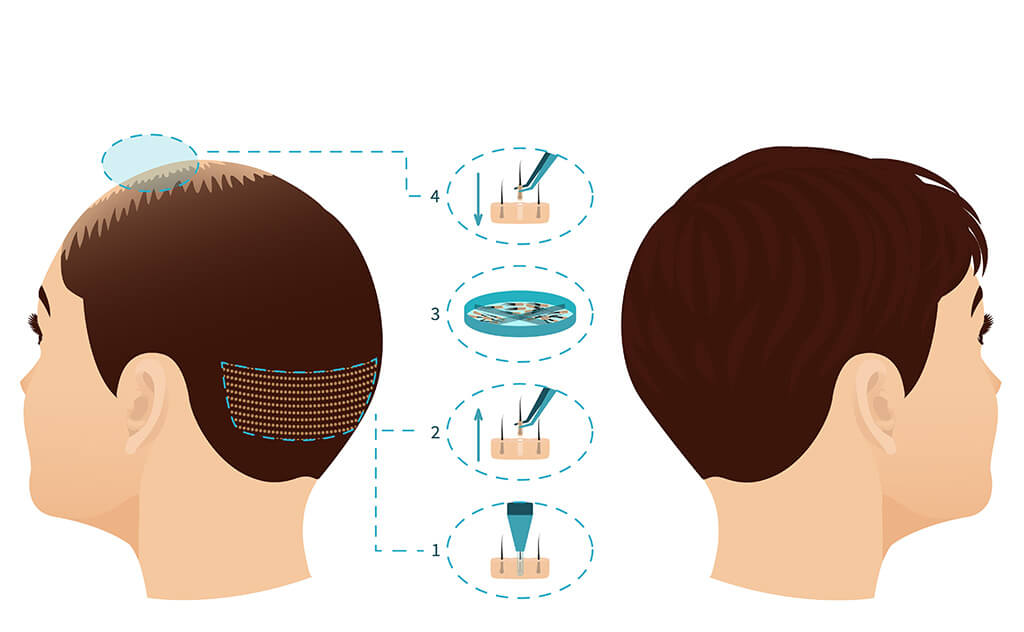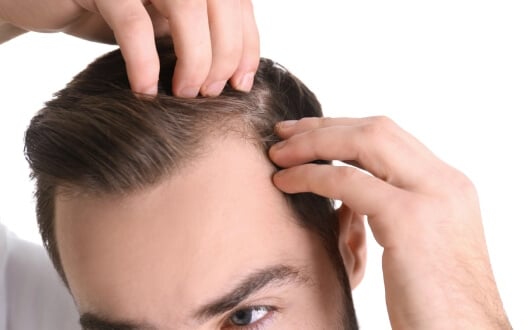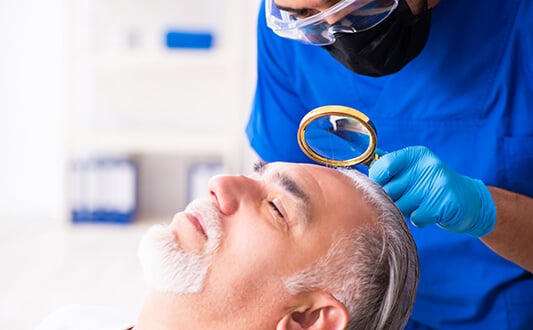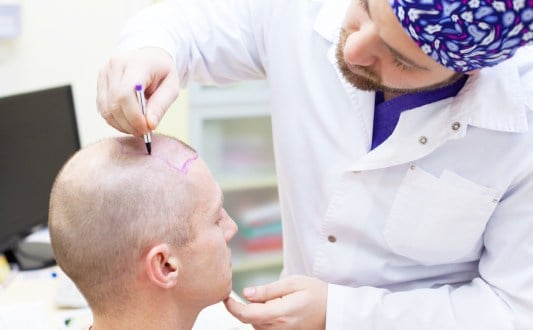Alopecia treatment is one of the most topical branches of aesthetic medicine in the 21st century. Actually, hair transplantation is the only technique that completely solves the problem of hair loss. This kind of treatment was first proposed in the 1950s by Dr. Orentreich. At that time surgeons used transplantation of whole skin flaps up to 5 mm in size to improve a patient`s appearance.
Modern equipment and level of knowledge have now introduced a more sophisticated correction of problem areas with the help of high quality individual hair follicles less than 1 mm in size. The name of such a technique is called FUE (follicular unit extraction) – sutureless hair transplantation with the help of individual hair follicles.
Content
- Causes of alopecia and methods of treatment
- Up-to-date techniques of hair transplant: FUT and FUE
- Who should think about FUE hair transplant?
- How the sutureless FUE hair transplantation is done?
- Peculiarities of hair care after FUE hair transplant
- Stages of full hair recovery after FUE hair transplant
- Reliable and trusted clinics for FUE hair transplant
Causes of alopecia and methods of treatment
Hair loss may occur at any age in men and women. The main causes of alopecia and hair growth disorders are:
- Genetic causes
- Hormonal disorders (increased level of male sex hormones – androgens, thyroid gland pathology, adrenal pathology)
- Age-related changes
- Continuous drug intake (antidepressants, anti-inflammatory drugs, oral contraceptives)
- Skin changes after surgeries, injuries, burns (cicatricial changes)
During the initial stages of alopecia, doctor recommends suitable treatment to stimulate the restoration of the patient`s own hair, namely, shampoos, creams and drugs etc. Some patients may use folk remedies. Once these kinds of treatment are ineffective or a patient wants to achieve lasting result in a short period of time, hair transplantation is then performed.
Currently dermatologists and surgeons of aesthetic medicine prefer minimally traumatic methods of hair transplantation, that do not damage donor areas. In order to achieve desirable results, doctors take from the donor areas not individual hair follicles, but grafts.
A graft is a structure that consists of 3-4 hair follicles and the surrounding layer of protective tissue. The procedure of graft harvesting is always followed by the healing process, the result of which depends on the doctor's qualification, accuracy of the donor area choice and technique of hair transplantation
Up-to-date techniques of hair transplant: FUT and FUE
FUT and FUE are the most promising modern techniques of hair transplantation. FUT (follicular unit transplantation of hair) is the method of hair transplant with the help of skin flaps, it`s also known as the ‘strip-method’. The FUT method uses skin flap from the back or lateral part of the head, as the hair in these areas is the most viable and resistant to unfavorable hormonal factors.
When hair transplant is performed by the FUT method, the doctor receives a large number of high quality neografts for subsequent hair transplantation relatively easily. The separated skin flap is examined under a high-resolution microscope and divided into separate grafts, which are used for hair restoration. Stereo-microscopic equipment performs the procedure as accurately as possible, without damaging harvested grafts.
Despite the ease of collecting donor hair, the FUT method has a number of peculiarities that you should take into consideration before making the decision about certain methods of treatment:
- Presence of the linear scar at the site of skin flap harvesting. No doubt, the scar is masked with the help of cosmetic sutures, but in the future it will be visible in people with short haircuts. In addition, the postoperative suture requires special care and additional visits to the surgeon for the final removing of the filaments.
- It will be necessary to limit physical activity for 1-2 weeks in the postoperative period.
- Harvesting grafts from the removed skin flap and their additional processing require time. Long period of staying outside the body reduces viability of the grafts and affects the final result of hair transplantation.
- Donor follicles for FUT hair transplantation are harvested exclusively from the head. In case the hair density on the back part of the head is reduced, it is impossible to obtain a sufficient amount of donor material and achieve the planned result of hair transplantation.
FUE (follicular unit extraction) hair transplant doesn`t have such limitations. With the FUE method the donor area is minimally damaged, as the doctor doesn't extract an extensive skin flap, but small individual grafts.
Who should think about FUE hair transplant?
FUE hair transplant has a number of advantages that allow the patient to go through the transplant procedure easily and achieve a natural look of restored hair:
- There is no visible linear scar in the donor area; the small point scars after grafts harvesting disappear quickly and will be completely masked by the surrounding hair
- The procedure is minimally traumatic, so the postoperative period takes only a few days; after this the patient returns to usual everyday life, including intensive physical activity
- As there is no wound in the donor area, the patient does not need to visit the surgeon once more for the control examination or removal of sutures
- The absence of linear scar after the surgery allows the patient to choose any desirable type of hairstyle, including a short haircut; furthermore, with the help of FUE method it is possible to mask old scars from previous FUT hair transplantation
- In the absence of the sufficient number of healthy hair on the back part of the head; donor grafts for hair transplantation may be taken from any part of the body
- Donor grafts are minimally processed before quickly transplanted to a new site, which increases their viability and quality of future growth
- Also the FUE hair transplant is used in patients with dense skin for carrying out FUT hair transplant or in patients with excessive scar formation
Review of relative limitations and side effects of FUE hair transplant:
- Absence of the qualified and experienced surgeon or professional equipment in the clinic
- Complete absence of areas for harvesting donor grafts
- Unusual pattern of hair growth and structure of the skin, that makes harvesting high quality grafts extremely difficult
- The need to transplant more than 6,000 grafts to restore natural hair growth pattern (in this case participation of several surgeons and assistants is necessary)
- Inflammatory diseases of the skin in the area of grafts harvesting or transplant
How the sutureless FUE hair transplantation is done?
During the first stage of hair transplant, the surgeon determines the area where donor grafts will be transplanted to restore the natural look. The best possible variant is to perform a 3D reconstruction and visualize the final result of hair transplantation. When transplanting eyebrows or beard, it is important to determine their shape in advance. Also, the doctor examines the direction of hair growth and distribution of hair at the donor site.
The back part of the head usually serves as the donor of hair follicles, as the hair in this area is genetically more viable and tolerates the transplantation better. To facilitate the harvesting of grafts the hair in the donor area is shaved to a length of 1-2 mm. This can cause certain discomfort in hair transplantation for women with long hair, who do not plan to tell everyone about the details of their treatment, so it is worthwhile to think about the options for headgear in advance. After providing local anesthesia of the donor area, the surgeon begins to harvest grafts. The procedure is absolutely painless, during the intervention patient can read or watch videos.
Grafts are harvested one by one, individually or by automated methods, for example, Neograft, ARTAS, Smartgraft, and Ugraf. Automated techniques allow doctor to get more grafts than manual graft extraction may provide. The number of obtained and transplanted grafts reaches 6,000 per day. It should be noted that this number of hair follicles is enough to restore hair loss of any complexity. Usually the operation requires about 2,000-4,000 grafts.
The quality of the obtained neografts for hair transplantation has the same importance as the quantity. Quality of grafts affects their viability and the pattern of hair growth in the future. Full grafts should contain all parts of the hair follicles. Also a protective layer of tissue should be present around the follicles in the grafts; that protects the hair from damage during transplantation and preserves grafts viability outside the body. Before the re-implantation of grafts the surgeon's assistants place harvested material in a special nutrient solution.
The surgeon's assistants carefully study obtained grafts under a high resolution microscope. This allows doctor to select the most high-quality material for the next stage of implantation. If necessary, grafts that contain up to 6 hair follicles are divided into individual follicles. This method is used in more intricate interventions, namely, transplanting the eyebrows and beard, as well as when forming a hair line on the forehead.
After selecting the necessary amount of donor material the surgeon proceeds to graft implantation. To perform hair transplantation, micro punches with a diameter of up to 0.5 mm are created in the problem area (the recipient zone); donor hair is placed into each punch. The implantation procedure also does not cause any discomfort to the patient, as everything is transplanted under local anesthesia.
FUE hair transplantation requires maximum concentration and responsibility from the surgeon and the team of assistants. Quality of the harvested grafts, speed and technique of hair transplantation, choosing correct areas for the follicles implantation – all these factors directly affect the final result of hair transplantation.
Peculiarities of hair care after FUE hair transplant
The postoperative period is painless. The only thing that can bother the patient is a temporary non-prominent edema involved in the procedure skin; edematous changes completely disappear in 1-3 days. Patients with high sensitivity may, if necessary, take painkillers (Diclofenac, Meloxicam).
After the completion of transplantation the doctor examines the patient and checks the condition of the follicles. The transplanted hair is additionally coated with a nutrient solution and a dressing is applied. It is recommended to not injure the area with transplanted hair during 24 hours.
In 24 hours the patient visits the doctor again for a follow-up examination. During this visit the doctor shows the patient how to wash his head. For additional stimulation of hair growth it will be necessary to wash head with the use of special remedies daily for several weeks.
The period of postoperative supervision of the patient lasts no more than 3 days; usually this period is sufficient for assessing the viability of grafts and consulting the patient on all aspects of further hair care.
Stages of full hair recovery after FUE hair transplant
Each patient, who chooses FUE hair transplantation, should know the stages of hair follicles engraftment and speed of new hair growth:
- Within 7-10 days after the operation the injured skin is healed, and microscopic scars are formed at the graft harvesting site.
- During the first stage, which lasts 2-3 weeks, hair from the transplanted follicles falls out. This is a completely natural process. Attention should be paid not to transplanted hair itself, but to the viable hair follicles that remain in the skin, as they are the source of subsequent hair growth.
- Hair growth from transplanted hair neografts will be apparently visible in 2-3 months.
- The natural look of the hair will be completely restored in 6-9 months. Appearance of the patient will correspond to the 3D model created by the surgeon before the treatment. The qualification and practical experience of the surgeon is a guarantee of successful achieving final goal of treatment.
Reliable and trusted clinics for FUE hair transplant
When choosing a clinic for hair transplantation, it is important to consider the following factors:
- Availability of modern equipment. Presence of equipment for automatic grafts harvesting is of particular importance
- Presence of an experienced team with qualified surgeon and his assistants. The surgeon should know several techniques of harvesting grafts – two-step (sharp) technique and three-step (blunt) technique
- The willingness of the surgeon to warrant the result of his work, it is a guarantee of desirable and lasting result of hair transplantation
- Reasonable hair transplantation cost. In most cases the cost of hair transplant depends on the number of grafts and the level of the clinic
- Privacy. This factor is important for patients who wish to avoid unnecessary attention and receive treatment out of the public eye
Taking into consideration all the above mentioned factors, it is worth to pay attention to the clinics of Turkey when choosing a clinic for FUE hair transplant. Traditionally, Turkish clinics admit not only citizens of their country, but international patients, as well. The development of international medical tourism obliges doctors to update medical knowledge and improve practical skills constantly. In their turn, clinics carefully monitor the quality of accommodation, examination and care of international patients. The clinics of the highest level are internationally certified for compliance with the requirements for medical tourism institutions.
Certified clinics of Turkey imply:
- The experience of surgeons, approved by the competent commission at the international level
- Optimal and stable ratio of the hair transplantation cost and its quality, without unreasonable overcharge
- The possibility of combining treatment with tourism, since the period of postoperative follow-up does not exceed 3 days
At present the only clinic, Skin Health Turkey, has confirmed the MTQUA (Medical Tourism Quality Alliance) certificate for hair transplantation, in particular with the FUE method. The clinic for hair transplantation is located in Istanbul, near the Bosporus Strait. A specialist, who is authorized for conducting such operations, is Dr. Oyku Celen.
In addition to the practice in Skin Health Turkey, Dr. Oyku Celen works in her own dermatological clinic. Dr. Oyku Celen is not afraid to share practical experience, her thematic presentations can easily be found in free access. Doctor has individual approach to every patient, carefully performing each operation. Usually Dr. Oyku Celen operates on no more than 1-3 patients per day. A few more clinics are now undergoing a certification process to meet the highest international standards of treatment.
The program of international patient, who is planning FUE hair transplant in Skin Health Turkey, includes:
- Booking the preferable hotel near the clinic where hair transplantation will be performed
- Meeting with an interpreter at the airport and transfer to a pre-booked hotel; in the presence of a language barrier – support by a coordinating interpreter during all the treatment process
- Signing of an official contract for the provision of medical services, arranging medical insurance for hair transplantation
- Going through the full cycle of hair transplantation, control visit to the doctor on the first day, and prolonging the period of postoperative observation up to three days, if necessary
- Assistance of the coordinating interpreter in personal services; organization of sightseeing program, entertainment or shopping program, if necessary
- Lifelong warranty on the result of hair transplantation
Choose treatment abroad and you will for sure get the best results!
The Booking Health portal presents 18 Turkish clinic where you can receive alopecia treatment with the help of hair follicle transplantation using FUE or FUT technique.
Authors:
The article was edited by medical experts, board certified doctors Dr. Nadezhda Ivanisova, Dr. Sergey Pashchenko. For the treatment of the conditions referred to in the article, you must consult a doctor; the information in the article is not intended for self-medication!
Sources:
National Center for Biotechnology
Read:
Why Booking Health - questions and answers
How to make right decision when choosing the clinic and specialist
7 reasons to trust to the rating of clinics on the Booking Health portal
Don't know where to start?
Contact Booking Health







